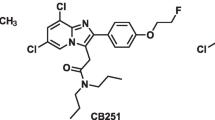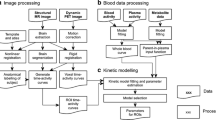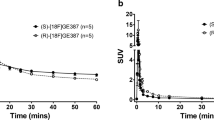Abstract
[11C]-PK11195 (PK11195) has been widely used with positron emission tomography (PET) to assess levels of the translocator protein 18 kDa (TSPO) as a marker of neuroinflammation. Recent ligands, such as [11C]-PBR28 and [11C]-DPA713, have improved signal-to-noise ratio and specificity for TSPO over PK11195. However, these second generation radiotracers exhibit binding differences due to a single polymorphism (rs6971) that leads to three genotypes: C/C, C/T and T/T associated with high, mixed and low binding affinities, respectively. Here we report that [3H]-DPA-713 in the presence of cholesterol or PK11195 has an accelerated dissociation rate from TSPO in platelets isolated from individuals with the T/T genotype. This allosteric interaction was not observed in platelets isolated from individuals with the C/C or C/T genotype. The results provide a molecular rationale for low binding affinity of T/T TSPO and further support the exclusion of these subjects from PET imaging studies using second generation TSPO ligands.

Similar content being viewed by others
References
Chauveau F, Boutin H, Van Camp N, Dolle F, Tavitian B (2008) Nuclear imaging of neuroinflammation: a comprehensive review of [11C]PK11195 challengers. Eur J Nucl Med Mol Imaging 35:2304–2319. https://doi.org/10.1007/s00259-008-0908-9
Costa B, Da Pozzo E, Giacomelli C, Barresi E, Taliani S, Da Settimo F, Martini C (2016) TSPO ligand residence time: a new parameter to predict compound neurosteroidogenic efficacy. Sci Rep 6:18164. https://doi.org/10.1038/srep18164
Coughlin JM et al (2014) Regional brain distribution of translocator protein using [(11)C]DPA-713 PET in individuals infected with HIV. J Neurovirol 20:219–232. https://doi.org/10.1007/s13365-014-0239-5
Guo Y et al (2015) Protein structure. Structure and activity of tryptophan-rich TSPO proteins. Science 347:551–555. https://doi.org/10.1126/science.aaa1534
James ML et al (2008) DPA-714, a new translocator protein-specific ligand: synthesis, radiofluorination, and pharmacologic characterization. J Nucl Med 49:814–822. https://doi.org/10.2967/jnumed.107.046151
Kreisl WC et al (2013) A genetic polymorphism for translocator protein 18 kDa affects both in vitro and in vivo radioligand binding in human brain to this putative biomarker of neuroinflammation. J Cereb Blood Flow Metab 33:53–58. https://doi.org/10.1038/jcbfm.2012.131
Li F, Liu J, Zheng Y, Garavito RM, Ferguson-Miller S (2015) Protein structure. Crystal structures of translocator protein (TSPO) and mutant mimic of a human polymorphism. Science 347:555–558. https://doi.org/10.1126/science.1260590
Limbird LE (2005) Cell Surface Receptors, Third edn. Springer, New York
Owen DR et al (2011) Mixed-affinity binding in humans with 18-kDa translocator protein ligands. J Nucl Med 52:24–32. https://doi.org/10.2967/jnumed.110.079459
Owen DR et al (2010) Two binding sites for [3H]PBR28 in human brain: implications for TSPO PET imaging of neuroinflammation. J Cereb Blood Flow Metab 30:1608–1618. https://doi.org/10.1038/jcbfm.2010.63
Owen DR et al (2012) An 18-kDa translocator protein (TSPO) polymorphism explains differences in binding affinity of the PET radioligand PBR28. J Cereb Blood Flow Metab 32:1–5. https://doi.org/10.1038/jcbfm.2011.147
Rupprecht R et al (2010) Translocator protein (18 kDa) (TSPO) as a therapeutic target for neurological and psychiatric disorders. Nat Rev Drug Discov 9:971–988. https://doi.org/10.1038/nrd3295
Selvaraj V, Stocco DM (2015) The changing landscape in translocator protein (TSPO) function. Trends Endocrinol Metab 26:341–348. https://doi.org/10.1016/j.tem.2015.02.007
Turkheimer FE, Rizzo G, Bloomfield PS, Howes O, Zanotti-Fregonara P, Bertoldo A, Veronese M (2015) The methodology of TSPO imaging with positron emission tomography. Biochem Soc Trans 43:586–592. https://doi.org/10.1042/BST20150058
Vivash L, O'Brien TJ (2016) Imaging microglial activation with TSPO PET: lighting up neurologic diseases? J Nucl Med 57:165–168. https://doi.org/10.2967/jnumed.114.141713
Acknowledgements
This work was supportedby NIH grants P30MH075673 and P30MH075673-S1.
Author information
Authors and Affiliations
Corresponding authors
Ethics declarations
Conflict of Interest
Authors declare that they do not have conflict of interest.
Rights and permissions
About this article
Cite this article
Rojas, C., Stathis, M., Coughlin, J.M. et al. The Low-Affinity Binding of Second Generation Radiotracers Targeting TSPO is Associated with a Unique Allosteric Binding Site. J Neuroimmune Pharmacol 13, 1–5 (2018). https://doi.org/10.1007/s11481-017-9765-2
Received:
Accepted:
Published:
Issue Date:
DOI: https://doi.org/10.1007/s11481-017-9765-2




